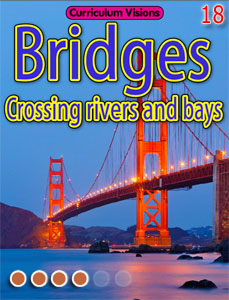A bridging point is a place where it is easy to cross a river.
There are many obstacles to getting about. Rivers, railways, canals, motorways and valleys can each make it very difficult for people to travel. But the biggest obstacles by far are valleys and rivers, especially when they are close to the sea. Usually there is nothing for it but to build a bridge. By the way, a bridge over a valley is often very long, and is called a viaduct. A bridge that carries a canal across a valley is called an aqueduct.
A bridging point is a place where it is relatively easy to cross a river. Unlike railways, roads and canals, you have no control over where a river will flow or how wide it might be. So you have to look for a place where the river is narrow, where there is good solid ground on both sides and that is more or less in the place that people want to cross it.
In the past, when people could not build bridges like the one you see here, people would ford the river or use a ferry.
Because bridges are very expensive, only a few bridges are built, and this tends to make routes gather towards the bridge. So it is not surprising that if a bridge is built near a town it tends to bring more business to the town. Towns without bridges tend to stay small.
The example shown here is one of the most famous bridges in the world. It is the Golden Gate Bridge, San Francisco, California. This bridge links two headlands at a narrows of a coastal inlet, or bay. On the long video you can see how it was built, and also a clip of the opening drive.
Another famous bridging point bridge is the double bridges over the River Tamar near Plymouth, Devon. Most big cities have multiple bridges, and some are very spectacular, such as Tower Bridge in London.





